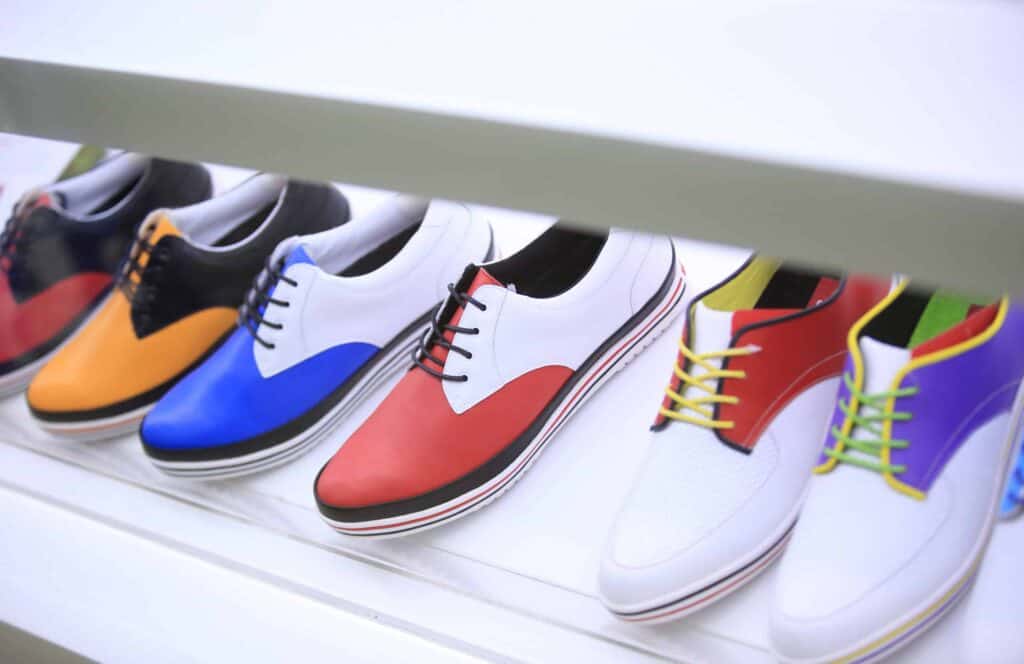If you’re the type of sportsperson that likes to look their best while they’re crushing the green in a round of golf, you might wonder why are golf shoes so ugly?! Often referred to as the rich person’s game, golf attire for men and women is typically very clean-cut with business casual dress such as polos, khakis, and skirts. Yes, it’s all very polished and clean…until you get to the shoes.
When people think of indisputably ugly golf shoes, they’re often picturing older styles from around the 1920s, like kilties with their fringed tongue or saddles with their reinforced leather instep. No doubt many of these styles don’t fit modern-day fashion, but the majority have died out for shoes much more reminiscent of the modern-day trainer.
Read on to learn about the evolution of style in golf shoes, from the popular 1920s style many see as ugly to the sleeker and much more functional sneaker-esque golf shoes of the modern-day. And for those of you who still despise the modern styles, we have a shortlist of golf shoes that might change your mind.

Why Some Think Golf Shoes are Ugly
It’s true. There are lots of ugly golf shoes out there. However, the idea is somewhat subjective. Everyone has a different take on what’s “ugly” as far as golf shoes go.
Golf has been around for over four centuries, so its shoes have had plenty of stylistic changes before reaching their current appearance. For the most part, when people think of golf shoes as “ugly,” they’re probably not picturing the modern-day shoes of the 21st century, but rather the more popular styles worn in the 1920s when golf was at its height of popularity.
To highlight the stylistic elements many modern-day golfers perceive as ugly in golf shoes, we’re going to walk through their evolution from the peak of golf popularity to today. This will demonstrate how far they’ve come and maybe convince those who even hate modern shoe styles that they were once worse, much worse.
Brief History of Golf Attire
As a sport, the modern version of golf was initially invented in 15th century Scotland, where most older golf attire, including shoes, got their stylistic inspiration. This is clearly demonstrated in popular golf shoe names, such as Gillies and Kilties, which we’ll discuss in further detail later.
Despite how old the sport is, golf didn’t start becoming more popular until the 19th century and then really boomed in the 1920s with the rise of golf tournaments.
Golfing attire was initially designed for functionality to battle the harsh winds and other elements of Scotland. Therefore, shoes weren’t created to be visually appealing but rather to be sturdy and durable. Of course, come the early 1900s, this changed with the rise of the “well dressed” golfer.
During this time, most prominently the 1920s, golfers aimed for more formal golfing attire with “plus-four” outfits and “spectator” shoes, so their class was visually apparent. It was this era when the most recognizable and arguably ugly golf shoes appeared until they slowly fell out of fashion by the 1940s when golfers tossed their expensive shoes for a sturdier pair to match their more casual outfits.
(Source: https://golftips.golfweek.usatoday.com/golf-clothing-etiquette-20037.html)

Old Style Golf Shoes
As you can see, the style of golf shoes has had some exceptional highs and lows, from prioritizing durability and functionality to being the height of sporting fashion and then receding once more towards comfort and casualness.
One could argue this constant fluctuation is what makes the majority of golf shoes so historically ugly because they either leaned too far towards functionality and forego appearance, or they leaned too far towards fashion that simply didn’t age well as the years passed.
Despite this, there are many elements of the 1920s golf shoes that carried over for decades and are likely the cause of people’s adverse attitudes.
Here are some of the most popular golf shoe styles and the elements that don’t particularly carry over well into 21st-century style.
Gillie Shoes
The gillie or ghillie shoes are largely inspired by Scottish culture as the name itself is derived from the Scottish Gaelic word for “boy.” These shoes are stylistically similar to the Oxfords, except they lack a tongue and are instead laced across the shoe’s instep, often with fringed laces.
Stylistically these shoes certainly aren’t the ugliest we will discuss. In fact, Oxfords, and similarly Derbies, are still worn by many individuals nowadays to match their formal or work attire. There are even low-lace sneakers that match this style.
Ultimately, what potentially puts people off these shoes is the exterior design they were blended with, of either the separate leather instep of the saddle shoe or the spectator’s contrasting leather colors.
Kiltie Shoes
Alright, if you’re looking for the pinnacle of ugly golf shoes, it’s probably the Kiltie. Design-wise, these shoes are Oxfords with a tongue, but it is the element that covers the instep and laces that get people.
Kilties are easily discernible by the piece of frayed leather covering the laces and eyelets of the shoe, if not more.
Although this was definitely a popular style at the time, it just hasn’t aged well. There are hardly any modern examples of this style apart from some old-styled slips-on shoes or slippers, and even these are far and few between. For the most part, this iconic element of the Kiltie has been replaced with a simple leather bow.
Everything you need to start playing golf!
Saddle Shoes
Saddle shoes, also referred to as “saddle Oxfords,” are another popular style that isn’t outwardly the worst option but would certainly look outdated with a modern outfit.
The defining element of these shoes is that they have a separate piece of “saddle” shaped leather covering the shoe’s instep. This leather could either match the shoe’s original color for a more cohesive look, or it could be an entirely different color that often sharply contrasts the first. If a saddle shoe did have two different colored leathers, this was referred to as a duotone.
Often, if the saddle were duotone, it would have a light base color like what and a dark saddle, like black or deep blue, and finished with laces of the lighter color.
Again, although this isn’t nearly as ugly as, say, the Keltie, this design style didn’t age well, particularly if the saddle shoe is duo-toned. There are some (albeit very few) examples of men’s Oxfords with this design, typically with really dark colors like black and deep purple, so the saddle isn’t too noticeable.
Otherwise, these are the type of shoes anyone would look at and know their style is at least sixty years old, and honestly, they look about two steps away from old bowling shoes.

Spectator Shoes
The final shoes on our list are the Spectator shoes, also known as Co-respondent shoes. These shoes are always created with two colored leathers or a canvas of one color and leather of another.
Like the saddle shoe, the biggest issue here is the exterior design and how sharply these colors contrast each other in outdated patterns.
Spectator shoes typically come in either white, black, or brown. On the bright side, this means they’re more likely to match any outfit, but on the downside, they have less personality and pop to them.
However, what they lose in color, they make up for in the pattern. These shoes will typically have dark-colored leather on the toes, heels, and right around the laces. There might also be a decorative swirl in this color that connects the bottom of the laces to the bottom of the instep.
The remainder of the shoe is typically in white and will have some dotted embroidery punched into the leather on the toe and around the instep.
Realistically, these shoes have some real style, and it isn’t hard to see why they were popular in the raging 20s. However, many of them look as if you turned a tuxedo into a shoe, and almost all of them look like they should be worn to a wedding or a corporate dinner, not the golf course.
Modern Era Golf Shoes
Now that we’ve discussed the older styles of golf shoes that people might be mistaken for modern golf footwear, it’s time to look at how far these shoes have come.
Most of the stylish elements of golf shoes that lasted the better half of the 1900s have all melted away for more clean, sleek, and functional designs more popularly used today.
Typically, when you look at a pair of modern golf shoes, they look almost identical to a regular pair of sneakers and trainers. Long gone are those stiff leather insteps and soles; now, people wear shoes made from nylon, synthetics, rubber, and other materials.
Leather is certainly still used, but it is paired with foam and cushioning for more comfort because nowadays, people want shoes that look good, but they want ones that feel good more. The biggest design difference now is that many golf shoes have spikes underneath for improved footing.
Although some modern golf shoes might hold on to a few old-school designs, particularly with the shoe instep, you can hardly call them ugly. Apart from the spikes, you probably wouldn’t be able to pick a pair of golf shoes apart from any other sneaker, trainer, or running shoe.

Most Stylish Golf Shoes for Men and Women
If you’re still not convinced that you can’t find a decent pair of golf shoes that don’t repulse you to wear, check out our list of the topmost stylish golf shoes for both men and women.
Best Men’s Golf Shoes:
Best Women’s Golf Shoes
Final Thoughts
Although there are elements of old-style golf shoes that many would deem as ugly today, this is ultimately a matter of opinion.
Fashion inevitably changes, even daily, and there will always be stylistic elements in patterns, materials, and designs that some will think aged well and are still applicable to modern tastes, while others will completely disregard as outdated. Golf shoes are just one example of this.
Whether you prefer the polished look of 1920s golf shoes or the modern sneakers/trainers of today, remember that you are free to express yourself however you please in your golf attire.
We do recommend that if you prefer older styles, that you find a modern version with spikes more functional elements to support your gameplay. But ultimately, the choice is up to you.
